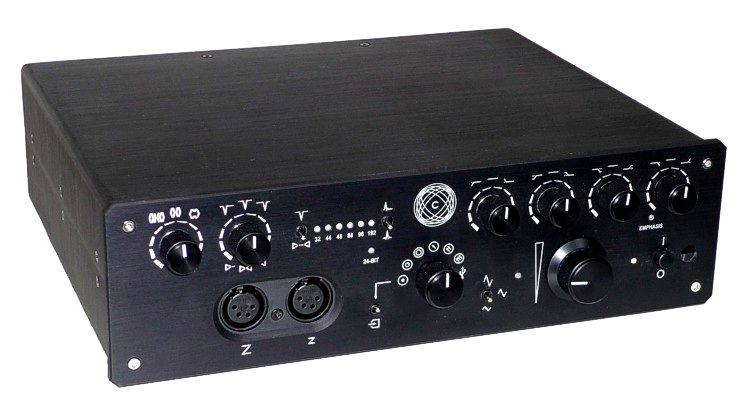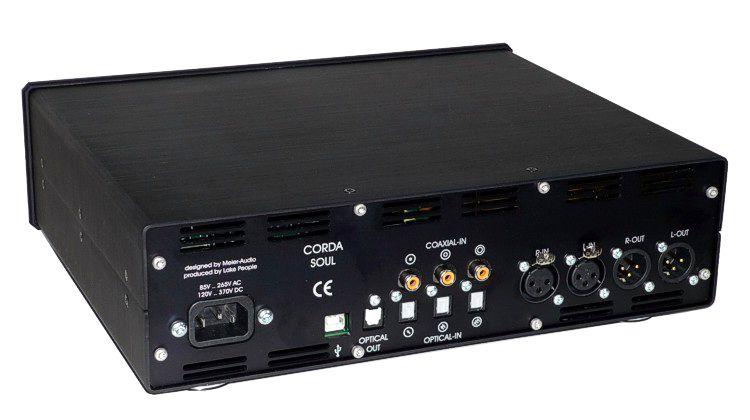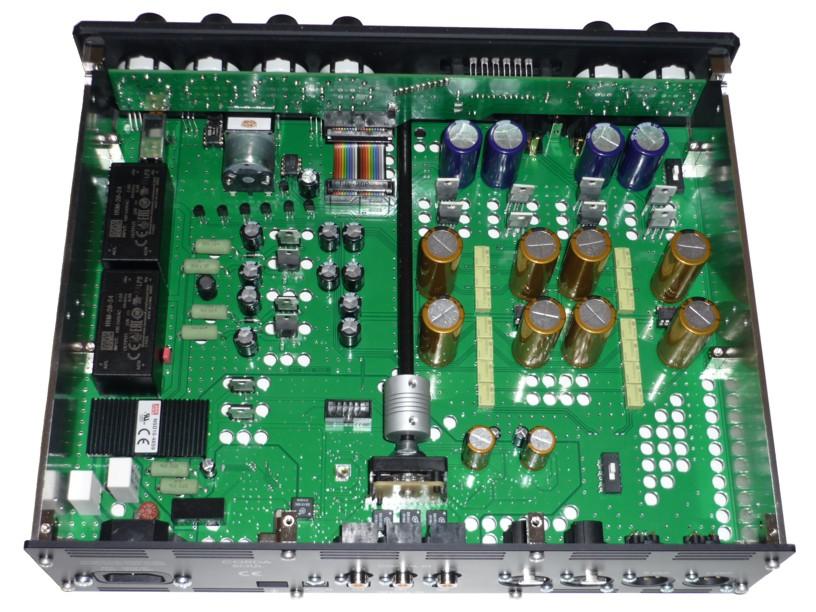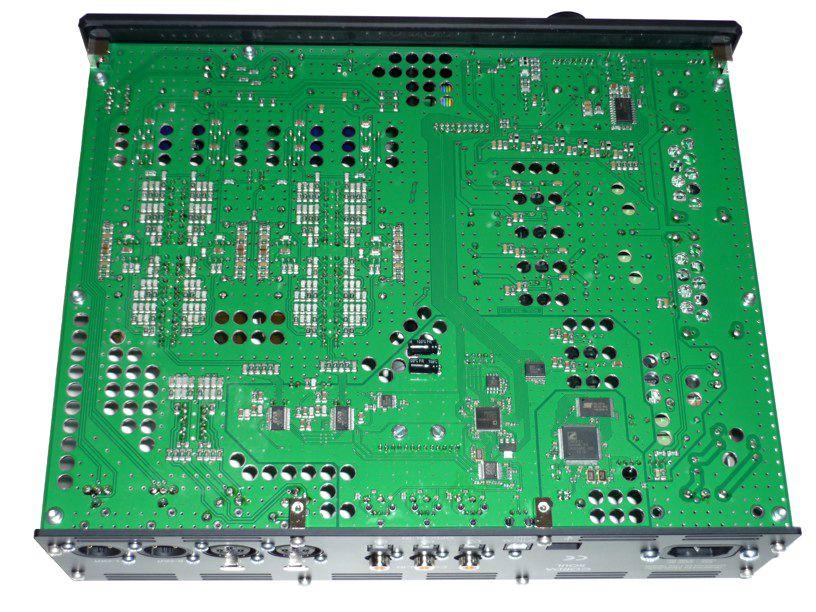MEIER-AUDIO
CORDA
CORDA
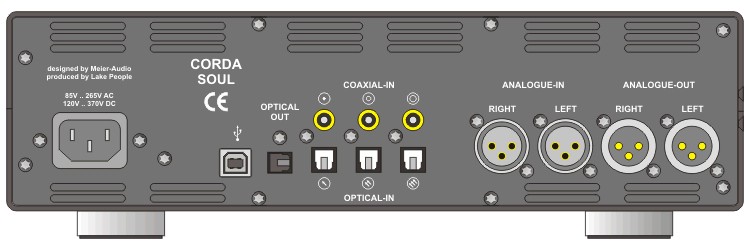


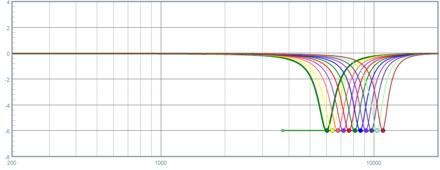
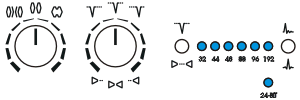
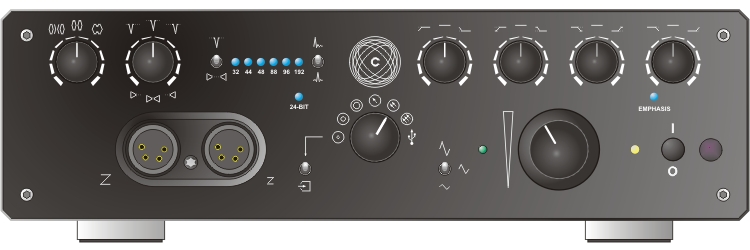
CORDA SOUL / CORDA SOUL MkII
Technical details:
Measures: 30.0 x 25.5 x 9.3 cm.
Weight: 2.7 kg.
Power supply: 85V .. 265V AC / 120V .. 370V DC.
Power uptake: 20 Watts.
Maximal amplification (1 kHz): -6 / +6 dB analog input.
................................................-11 / -5 dB (SOUL MkII).
Maximum effective output voltage:
........................................18 Vrms (analog input).
........................................8 Vrms digital input.
........................................9 Vrms digital input (SOUL MkII).
Maximum output current: 600 mA / channel.
Frequency range:
...............................DC .. 80 kHz analog inputs.
...............................DC .. (14.5 kHz .. 80 kHz) digital inputs.
(upper limit depending on sampling rate and digital filter selected).
Input impedance: 40 kOhm balanced.
20 kOhm unbalanced.
Output impedance: 0 / 120 Ohm (headphone).
120 Ohm balanced preamplifier outputs.
Discrete volume control. Typical stepsize 0.8 dB, 63 steps.
Measures: 30.0 x 25.5 x 9.3 cm.
Weight: 2.7 kg.
Power supply: 85V .. 265V AC / 120V .. 370V DC.
Power uptake: 20 Watts.
Maximal amplification (1 kHz): -6 / +6 dB analog input.
................................................-11 / -5 dB (SOUL MkII).
Maximum effective output voltage:
........................................18 Vrms (analog input).
........................................8 Vrms digital input.
........................................9 Vrms digital input (SOUL MkII).
Maximum output current: 600 mA / channel.
Frequency range:
...............................DC .. 80 kHz analog inputs.
...............................DC .. (14.5 kHz .. 80 kHz) digital inputs.
(upper limit depending on sampling rate and digital filter selected).
Input impedance: 40 kOhm balanced.
20 kOhm unbalanced.
Output impedance: 0 / 120 Ohm (headphone).
120 Ohm balanced preamplifier outputs.
Discrete volume control. Typical stepsize 0.8 dB, 63 steps.
The mission of MEIER-AUDIO always has been to produce gear with an optimal price-performance-ratio. It never was the aim to make the best-of-all headphone amplifiers.
However, over the last 20 years the technical standards of headphones have improved considerably and with many ideas circulating in my head I have been seduced to develop a best-I-can-make DAC/headamp combo without any limitations towards costs. I called it the SOUL.
The SOUL not only combines a DAC and a headphone amplifier into one device but also has a built-in DSP (Digital Signal Processor). Thus the digital input signals can be processed before they're converted into an analog signal by the DAC-section. The DSP operates with 64-bit precision and this allows to implement tone-controls, balance controls, crossfeed and a few other functions with a precision that never could be realized with any analog circuitry. Also important, the DSP makes it possible to shift the first stage of the FF-technique forward into the digital domain. Thus the DA-conversion stage as well as all the analog amplification stages fully benefit from the FF-technique and this enhances sound quality considerably.
The front of the SOUL has a larger number of control elements which underpins the versatility of the amp. Below please take a look at the design of the amp.
However, over the last 20 years the technical standards of headphones have improved considerably and with many ideas circulating in my head I have been seduced to develop a best-I-can-make DAC/headamp combo without any limitations towards costs. I called it the SOUL.
The SOUL not only combines a DAC and a headphone amplifier into one device but also has a built-in DSP (Digital Signal Processor). Thus the digital input signals can be processed before they're converted into an analog signal by the DAC-section. The DSP operates with 64-bit precision and this allows to implement tone-controls, balance controls, crossfeed and a few other functions with a precision that never could be realized with any analog circuitry. Also important, the DSP makes it possible to shift the first stage of the FF-technique forward into the digital domain. Thus the DA-conversion stage as well as all the analog amplification stages fully benefit from the FF-technique and this enhances sound quality considerably.
The front of the SOUL has a larger number of control elements which underpins the versatility of the amp. Below please take a look at the design of the amp.
Click to enlarge
The left-most dial controls crossfeed. In the upper (neutral) position the output is plain stereo. Turning the dial clockwise activates headphone crossfeed (5 levels), turning anti-clockwise activates loudspeaker crossfeed (5 levels). The latter widens the soundstage of loudspeakers and is especially usefull when loudspeakers are placed relatively close together. However, some people also like these settings with headphones as it places you just in the middle of the music.
The second dial from the left has three different functions:
- With loudspeaker crossfeed activated this dial adjusts the delay between the direct signal and the crossfeed signal. The optimal delay time depends on the positions of the loudspeakers and the size of the head of the listener.
- In stereo or in headphone crossfeed mode and with the switch to the right of the second dial in lower position the dial controls channel balance. People with bad hearing thus can compensate for different sensitivities of their ears.
- With loudspeaker crossfeed activated this dial adjusts the delay between the direct signal and the crossfeed signal. The optimal delay time depends on the positions of the loudspeakers and the size of the head of the listener.
- In stereo or in headphone crossfeed mode and with the switch to the right of the second dial in lower position the dial controls channel balance. People with bad hearing thus can compensate for different sensitivities of their ears.
- In stereo or headphone crossfeed mode and with the switch to the right in upper position the dial controls the central frequency of a 6dB, Q=2 notchfilter. Many headphones do have a distinct resonance frequency in the 6..11 kHz range due to the entrapped air-volume between driver and ear. Proper application of the notch filter will lower the energy at the resonance frequency and our tests (using HD800, HE-500, T1, ...) have shown that this can distinctively improve sound quality.
At the right of the front four dials offer tone control and a LED indicates the emphasis-status of the incoming signal.
LLF; de-/increase of frequencies below 170 Hz
LF; de-/increase of frequencies below 500 Hz
HF; de-/increase of frequencies above 1.5 kHz
HHF; de-/increase of frequencies above 4.5 kHz
Stepsize 0.8 dB, range +/- 4 dB.
The effects of the separate controls are cumulative.
LLF; de-/increase of frequencies below 170 Hz
LF; de-/increase of frequencies below 500 Hz
HF; de-/increase of frequencies above 1.5 kHz
HHF; de-/increase of frequencies above 4.5 kHz
Stepsize 0.8 dB, range +/- 4 dB.
The effects of the separate controls are cumulative.
Seven LED's indicate sampling frequency and bit-resolution of the incoming signal. Especially with computer audio this is a great help to check the software settings.
A switch to the right of the LED's allows to change the filter settings of the DAC-chip used. One can choose between classic filtering (phase correct, brickwall) and a minimum-phase filter without pre-ringing.
A switch to the right of the LED's allows to change the filter settings of the DAC-chip used. One can choose between classic filtering (phase correct, brickwall) and a minimum-phase filter without pre-ringing.
A central dial selects the digital input source and to its left there is a seperate switch to activate the analog inputs.
To its right a switch allows to select between low, medium, and high gain. bi-color LED indicates the gain setting. This gain is applied in the digital domain (-6db, 0dB, +6dB).
To its right a switch allows to select between low, medium, and high gain. bi-color LED indicates the gain setting. This gain is applied in the digital domain (-6db, 0dB, +6dB).
The SOUL has a discrete volume control with 64 positions. Typical stepsize is around 0.8 dB. For visual control the ON-OFF LED of the amp changes it's color/intensity with each step.
The volume-potentiometer is motor-controlled and can be learned to react to any two buttons on any infrared remote control.
The volume-potentiometer is motor-controlled and can be learned to react to any two buttons on any infrared remote control.
The SPDIF input signals are decoded and de-jittered by a WM8804 SPDIF-receiver-chip. The clock used is an extremely high-quality TCXO.
The digital audio signal is then fed into an ADAU1451 DSP for all processing concerning the FF-technique, crossfeed, channel balance, notchfilter, and tone-controls.
After processing the digital signal is converted to an analog signal using two WM8741 DAC-chips in dual-mono-mode.
Each analog signal (four signals in total as this is a balanced amp) is amplified/buffered by one single amplification stage, using an AD797 opamp (biased into class-A) that is buffered by two BUF634s (in high-current-mode). Volume is set by changing the feedback-resistance of the opamp. This results in a much lower background noise and much lower distortion then using a conventional approach with a potentiometer in front of an amplification stage with fixed amplification factor. This amp is "black", even with the most sensitive headphones.
The USB-input uses the CM6631 from C-Media to receive data in asynchronous mode from your PC. These are then send in SPDIF-format to the WM8804. The use of extremely high-quality TCXOs guarantee a very jitter-free operation.
The SOUL accepts PCM signals with samling frequencies of 32, 44.1, 48, 88.2, 96, and 192 kHz. Bit-resolutions upto 24-bit.
DSD-signals and 384 kHz signals can not be processed by the DSP and therefore are not accepted. I'm sorry for that!
The amp has four separate switched powersupplies. One for the digital section, one for the USB section, and two for the positive and the negative supply lines of the analog amplification stage. The output of each supply is RC filtered and further down-regulated with the use of analog voltage regulators. There are separate regulators for the opamps and the buffers. This, together with a total of around 70,000 uF (!!!) buffer-capacity results in extremely stable supply voltages. Sound-critical capacitors are Nichicon Fine Gold.
The switched powersupplies work with a typical switching frequency of 70 kHz. This is far beyond the limit of human hearing and thus any noise induced by the supplies is inaudible. There is no humm or any noise audible produced by the powersupplies.
Great care has been taken in the choice of the components used. Neutrik XLR-sockets, an ALPS potentiometer (although it does not carry an audio-signal) for smooth operation, LORLIN siver-plated rotary switches, sealed relais, etc.... all contribute to a high life-time-expectancy.
The sound of the SOUL is very fluent and silky, with an extremely high level of micro-detail. With the tone controls deactivated it is very neutral, without any wow-effect but with great inner logic.
Activation of the tone controls and/or notch filter offers great possibilities to adapt sound to personal taste or to compensate for sonic deficiencies of the specific headphone used.
The digital audio signal is then fed into an ADAU1451 DSP for all processing concerning the FF-technique, crossfeed, channel balance, notchfilter, and tone-controls.
After processing the digital signal is converted to an analog signal using two WM8741 DAC-chips in dual-mono-mode.
Each analog signal (four signals in total as this is a balanced amp) is amplified/buffered by one single amplification stage, using an AD797 opamp (biased into class-A) that is buffered by two BUF634s (in high-current-mode). Volume is set by changing the feedback-resistance of the opamp. This results in a much lower background noise and much lower distortion then using a conventional approach with a potentiometer in front of an amplification stage with fixed amplification factor. This amp is "black", even with the most sensitive headphones.
The USB-input uses the CM6631 from C-Media to receive data in asynchronous mode from your PC. These are then send in SPDIF-format to the WM8804. The use of extremely high-quality TCXOs guarantee a very jitter-free operation.
The SOUL accepts PCM signals with samling frequencies of 32, 44.1, 48, 88.2, 96, and 192 kHz. Bit-resolutions upto 24-bit.
DSD-signals and 384 kHz signals can not be processed by the DSP and therefore are not accepted. I'm sorry for that!
The amp has four separate switched powersupplies. One for the digital section, one for the USB section, and two for the positive and the negative supply lines of the analog amplification stage. The output of each supply is RC filtered and further down-regulated with the use of analog voltage regulators. There are separate regulators for the opamps and the buffers. This, together with a total of around 70,000 uF (!!!) buffer-capacity results in extremely stable supply voltages. Sound-critical capacitors are Nichicon Fine Gold.
The switched powersupplies work with a typical switching frequency of 70 kHz. This is far beyond the limit of human hearing and thus any noise induced by the supplies is inaudible. There is no humm or any noise audible produced by the powersupplies.
Great care has been taken in the choice of the components used. Neutrik XLR-sockets, an ALPS potentiometer (although it does not carry an audio-signal) for smooth operation, LORLIN siver-plated rotary switches, sealed relais, etc.... all contribute to a high life-time-expectancy.
The sound of the SOUL is very fluent and silky, with an extremely high level of micro-detail. With the tone controls deactivated it is very neutral, without any wow-effect but with great inner logic.
Activation of the tone controls and/or notch filter offers great possibilities to adapt sound to personal taste or to compensate for sonic deficiencies of the specific headphone used.
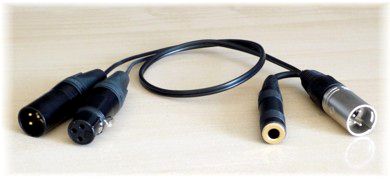
To keep signal paths short the symmetric output signals of the DAC-chips or nowhere desymmetrized. Most chips have a rather noisy common-mode signal and thus it was thought that single ended connections were not possible.
Surprisingly however testing revealed each single output of the SOUL to be very clean. Therefore it is well possible to connect single ended heaphones. An adapter is needed that we happily provide, if requested.
Surprisingly however testing revealed each single output of the SOUL to be very clean. Therefore it is well possible to connect single ended heaphones. An adapter is needed that we happily provide, if requested.
If interested in one of these very special amplifiers, please do not hesitate and drop me a mail.
Cheers
Jan Meier
Cheers
Jan Meier
A key element in the sound quality of the SOUL is the FF-technique. In the digital domain the amplitudes of the low frequency audiosignals are lowered to make the job of the DA-converter chips and the analog amplification stages more easy. At the last amplification stage the balance is restored by a stronger amplification of the same low frequency signals.
After building the SOUL amplifiers the idea came to not only reduce the amplitudes of the low frequency components but also to digitally increase the amplitudes of the highest frequency components. These are generally of very low amplitude and thereby SNR-ratio is relatively low and distortion relatively high (The linearity of DA-converters generally is worse at low level signals). Again, the balance can be restored at the last amplification stage.
The idea could be easily implemented in an existing SOUL amplifier and tested very favourably. The sound became even more fluent and whereas the original amp/DAC is slightly "brittle" on top, the modified amp has a rounder sound with a little bit more micro-detail. Differences are small but noticable. Within my television-setup for instance, human voices are simply more easy to understand.
This modified version of the amp is now offered for sale as the SOUL MkII.
One should be noted though, that this new version also has two drawbacks:
When using the analog inputs the amplification factors are 11 dB lower than on the original version. Not a big point if you don't use analog sources or a source with a high output voltage but ........
Secondly, high level, high frequency non-audio test signals will make the DA-converter clip. This distortion will not appear with regular audio signals (as these have low level high frequency components only) but if you use the amp for other purposes .......
People that already own a standard version of the SOUL can have their amp upgraded/modified.
After building the SOUL amplifiers the idea came to not only reduce the amplitudes of the low frequency components but also to digitally increase the amplitudes of the highest frequency components. These are generally of very low amplitude and thereby SNR-ratio is relatively low and distortion relatively high (The linearity of DA-converters generally is worse at low level signals). Again, the balance can be restored at the last amplification stage.
The idea could be easily implemented in an existing SOUL amplifier and tested very favourably. The sound became even more fluent and whereas the original amp/DAC is slightly "brittle" on top, the modified amp has a rounder sound with a little bit more micro-detail. Differences are small but noticable. Within my television-setup for instance, human voices are simply more easy to understand.
This modified version of the amp is now offered for sale as the SOUL MkII.
One should be noted though, that this new version also has two drawbacks:
When using the analog inputs the amplification factors are 11 dB lower than on the original version. Not a big point if you don't use analog sources or a source with a high output voltage but ........
Secondly, high level, high frequency non-audio test signals will make the DA-converter clip. This distortion will not appear with regular audio signals (as these have low level high frequency components only) but if you use the amp for other purposes .......
People that already own a standard version of the SOUL can have their amp upgraded/modified.
CORDA SOUL MkII
